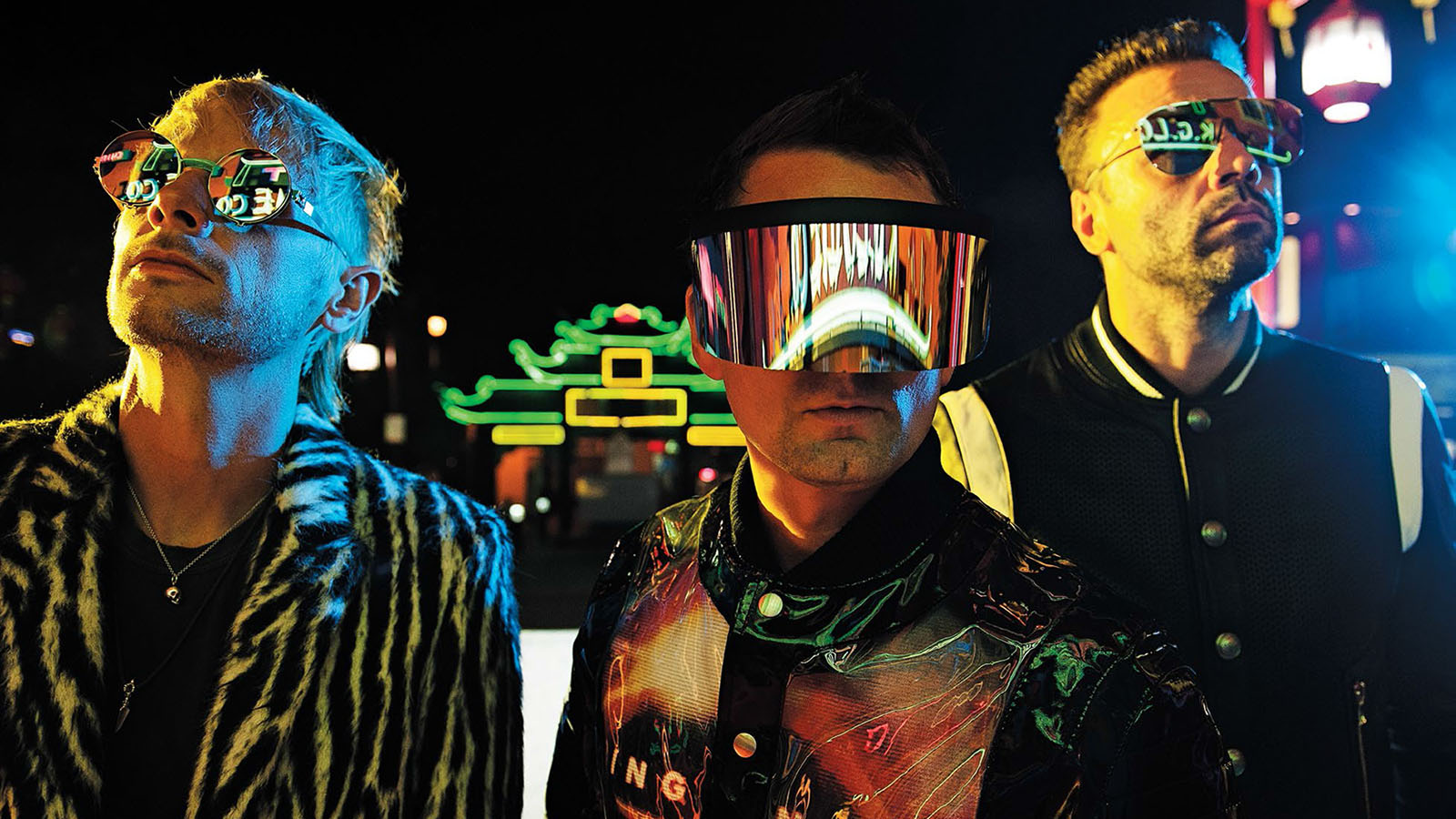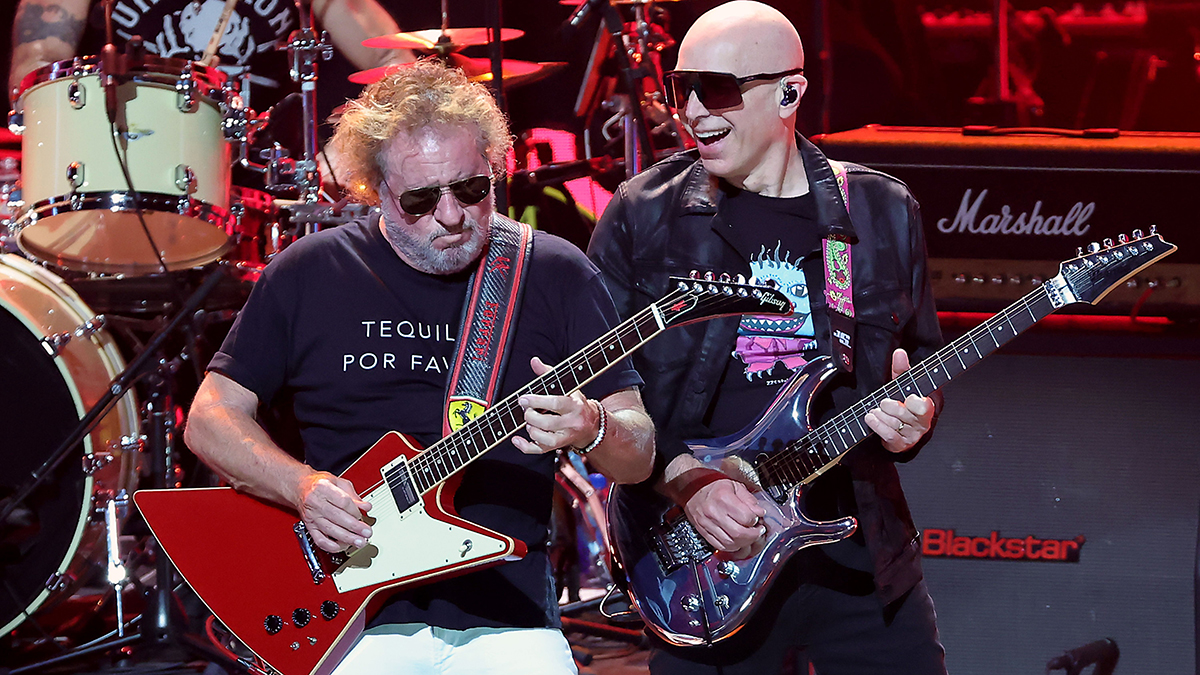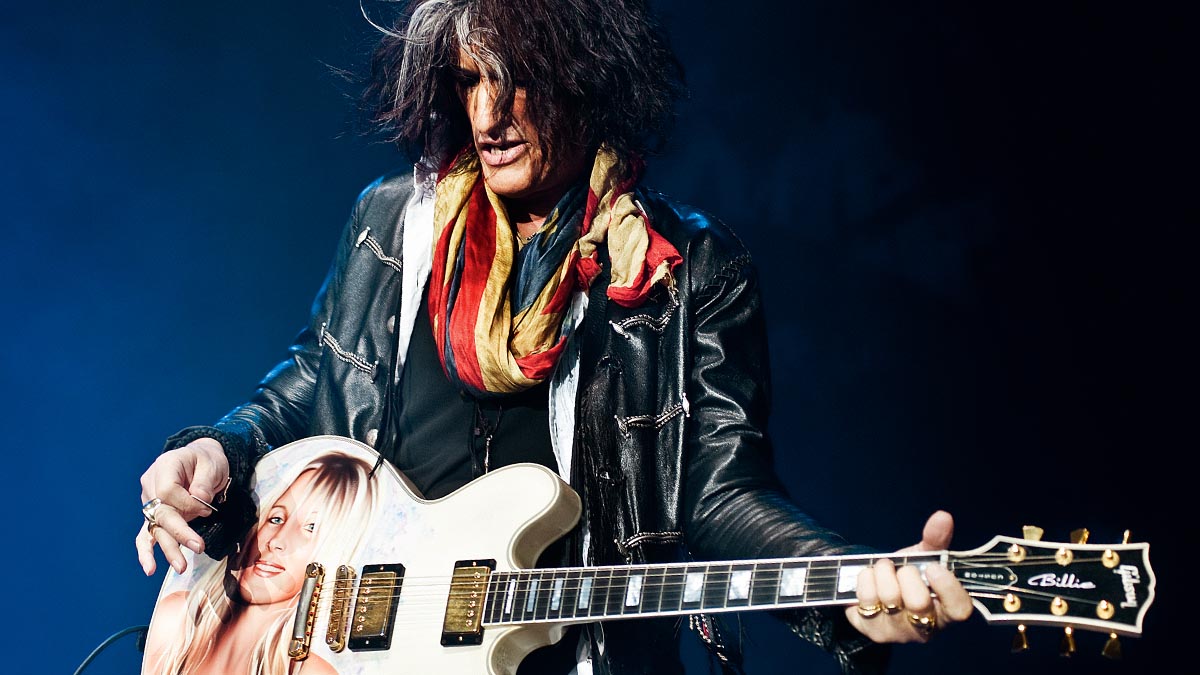Muse Main Man Matt Bellamy Talks New Album, the Cinematic 'Simulation Theory'
"I’m looking to try to create my own sound and my own take on the instrument."

There’s always been certain otherworld-liness inherent in Muse’s interstellar stadium-prog rock, whether they’re conjuring the sound of rampaging apocalyptic armies in “Knights of Cydonia,” from 2006’s Black Holes and Revelations, or crafting billowing tufts of symphonic grandeur with the three-part “Exogenesis” suite from 2009’s The Resistance.
But when it came to the British trio’s new and eighth studio album, Simulation Theory, singer and guitarist Matt Bellamy opted to leave this world behind entirely, immersing himself and his music in a sort of virtual reality. “I’m talking about things like gaming and living in an imaginary world online on the album,” he tells Guitar World. “This idea of getting out of the moment that we live in and going into a nostalgic sort of dreamland that’s outside of this time.”
And really, can you blame the guy for looking for an escape hatch?
“It was an aesthetic choice, but I guess you could also say it was partly political,” Bellamy admits. “We live in complicated times, and wanting to get away from them is probably a natural thing.”
But that aesthetic choice to, as Bellamy puts it, “distort reality,” also had genuine musical ends: “It made us go into a place that isn’t the traditional Muse sound,” he says.
True to Bellamy’s word, Simulation Theory is far from the traditional Muse sound — which is saying something indeed, given how untraditional Muse’s music is to begin with. But on Simulation Theory the band, which also includes bassist Chris Wolstenholme and drummer Dominic Howard, find a way to build upon what is already a remarkably singular sound. There’s plenty of Muse-isms in the throttling grooves of “Pressure,” the celestial rock of “Blockades” and the epic sweep of opener “Algorithm.” But there’s also an r&b and funk edge to tracks like “Break It to Me” and “Thought Contagion,” an overt global pop influence on “Something Human” and “Get Up and Fight” and a full-on electro-Prince pastiche, “Propaganda” (which also features — because why not? — an acoustic slide solo).
And while Simulation Theory is far from the band’s most guitar-centric record — there’s no aggro-riffing along the lines of, say, “Stockholm Syndrome” — there’s still plenty of enthralling playing to be found in the album’s 11 tracks, with Bellamy continuing to display the blend of virtuosity and idiosyncratic creativity that has led him to become one of the 21st century’s few true guitar heroes. This time, you just have to be a bit more patient in waiting for those moments. But, Bellamy says, “When the guitar is there, it’s there because it has to be there. It’s there because it’s doing something that is being featured.”
Get The Pick Newsletter
All the latest guitar news, interviews, lessons, reviews, deals and more, direct to your inbox!
The bottom line, he says, is that “there are no rules anymore about what defines a genre or a particular style of music. And I think that’s great.” And with Simulation Theory, Bellamy continues, “we’re embracing the freedom that defines the times we’re in.”
![[from left] Chris Wolstenholme, Dominic Howard and Matt Bellamy](https://cdn.mos.cms.futurecdn.net/ZovMnSH5WbbEDoxagfUNtF.jpg)
How did Simulation Theory come together?
It was quite a gradual and sporadic process. It wasn’t like most albums, where we just go into the studio for a couple months. This one was done in bits and pieces here and there, and spread over the last year or so. A lot of it we approached one song at a time, and I quite enjoyed that because it broke up the process and we weren’t worried about any sort of deadline. It felt less pressured and a bit more free.
But our general approach on the album was that most of the songs were written and demoed in one form and then ended up being produced in a very, very different way to that. The first song we did, which was “Something Human,” was originally very much a stripped-down, acoustic-only type song. But in the end we tried our best to make it more synthetic sounding, adding lots of layers of synthesizers and unusual instruments to take it away from sounding too organic. And we took the same approach with the next song, “Dig Down,” which, if you listen to it on the deluxe version of the album, you’ll hear it was originally like a gospel thing. But again, we produced it very differently using synthesizers and programmed drums and stuff like that to end up in a very different place. Then when we got to the next song, which was “Thought Contagion,” that was originally a mellow piano tune that ended up being a much more epic-sounding rock song. And at that point I started to develop the concept for the album, this idea of simulation and taking yourself outside of reality and going into an alternate universe of some kind.
Generally speaking, rock bands usually tend to be concerned with making their music sound more, not less organic. It’s interesting that you were motivated by a sort of opposing force.
Yes. I feel like Muse has always sort of occupied that space. Although on our last album, [2015’s] Drones, we very much went away from that otherworldly, synthetic kind of thing and toward a more rock approach, focusing primarily on guitar, bass and drums as the main instrumentation for every song. Because we were trying to get these raw, organic, live performances. This time we wanted to return to where I think Muse is at its best, which is this convergence between the organic and the synthetic.
You mentioned the song “Thought Contagion.” That one is interesting in that, in addition to transforming it from a piano tune into an electric rock song, you also bring in an r&b vibe. It sounds like you used 808-style drums for the rhythm.
That’s exactly what it is! That’s an authentic 808 drum machine in the verses. It’s not a plug-in version. It’s the real thing.
What led you to want to bring in all these different sounds, and in a very overt way?
In some ways it’s embracing the times we’re living in. As a rock band in this decade, there’s no reason that, from a production aspect, we have to restrict ourselves to the instruments that we’re mostly trained to use, which are guitar, bass and drums, and maybe piano. Another thing is that we live in this streaming music world now where everybody, or most people at least, listen to lots of different genres. We’re no longer in an age where people identify themselves purely with one genre of music, like how the 20th century was the rock and pop culture. Now, people just love the music they love. And I find that quite exciting because that reflects the way I’ve always been about music.
As far as acknowledging the changing times, I recall a recent interview where you discussed the fact that, in this decade, the guitar isn’t used so much as a lead instrument anymore. It’s more of a textural accompaniment.
I did say that. But actually, I wouldn’t mind rephrasing that quote. I think maybe using the word “lead” was misleading. Because if anything, the only kind of guitar that is relevant, or at least still useful, nowadays, is guitar that is showcased as being a guitar. And by that I mean the guitar is no longer heard just strumming away in the background and creating a sort of pad-like sound. In the Nineties, power chords were this sort of defining thing. They were a way of saying, “Oh, we’re a rock band.” Whereas in this decade the guitar is not usually the dominant sound in a song. But it is still a lead instrument, in that when it’s featured, it’s featured. And that’s kind of the way I treat the guitar on this album.
Whereas some guitar players might fight against the changing role of the instrument in rock, and yearn for a return to the big-riffs-and-epic-solos template of the Seventies, you seem to be pretty comfortable with where things are heading.
Yeah, for sure. Maybe that’s because I play other instruments, too. So I’ve never totally identified myself as just a guitar player or piano player or singer. If anything, I identify myself as a sort of music creator. Also, rock music as a genre is shifting, and it has to shift. It’s no longer a dominant force on the pop charts. So I think finding ways to incorporate other instrumentation into Muse has been a sort of passion of ours, and it’s something we’re sticking to.

What was your main gear setup on Simulation Theory?
Amp-wise, I have a [Marshall] JTM45, a vintage one from the early-Sixties. I also used a Vox AC30 quite a lot, as well as a Diezel. Across those three amps is where I got most of my sounds. And then I put in a few direct sounds on this album, where I’d just DI the guitar through, for example, a [Neve] 1073 mic preamp and crank up the gain on that quite a lot in order to get more of a fuzz feeling.
What would be an example of a DI guitar sound on the record?
The guitar riff in “Break It to Me” is a DI sound as well as an amp sound. “Get Up and Fight” is partially a DI sound, as is the guitar solo in “Dig Down.” Sometimes DI sounds, especially when played with interesting fuzzes, feel a bit more contemporary than mic’ing up an amp, you know? They cut through a little bit differently.
How about guitars?
I pretty much used my main black Manson [signature] guitar for everything. I’ve got a few of them that I use on tour, but it’s essentially a standard black Manson. It’s one that I designed a few years ago, and it’s sort of between a Fender Telecaster and maybe a Gibson SG in terms of body consistency and shape, weight sound. There are two songs on this album — “Propaganda” and “Something Human” — where I play acoustic, and for those songs I used a Manson that I had built for this album.
How did you approach effects?
I’ve got an effects rack that I use on tour that consists of a Fractal system. But in the studio I tend to use a selection of pedals. I used an interesting reverb on a couple of songs, including “The Dark Side,” that belonged to Rich Costey, who also produced that song. It was a black Space Echo type of pedal. And something else that was quite interesting was the Korg SDD [Korg SDD-3000 digital delay]. It has the same circuit board as the original Korg delay from the early-Eighties, which the Edge uses. And they brought out a pedal version of that.
Another thing I used on this album was guitar synth. It features a fair bit, especially on “The Dark Side” guitar solo and also the “Break It to Me” solo. I had a Fishman pickup on my guitar, which attached to a synthesizer. We managed to get all the parameters of my playing — dynamics, note bending, picking style, everything — and then basically translate it into MIDI information, which we could then send to any synthesizer we wanted. So, for example, the guitar solo on “The Dark Side” is actually my guitar going into an amp, probably the Marshall, plus it’s going into a Prophet V. And whatever I was playing, the synth would respond accurately to that. The technology has been around for a while, but it’s much more cutting-edge than it has been at any point in time. So it’s very exciting.
You tend to gravitate toward very tweaked, and often extreme, guitar sounds, whether it’s through employing a guitar synth or incorporating effects into the circuitry of your guitars. What do you find appealing about those types of sounds?
I like the idea of creating something that differentiates me from the history of the guitar. I’m looking to try to create my own sound and my own take on the instrument. Because for me personally, when I pick up a Fender Stratocaster, I tend to immediately start going bluesy. Before you know it, I’m playing Hendrix and Clapton riffs. It’s a similar thing when I play a Les Paul. I don’t know what it is about the shape of an instrument or the type of sound that it produces, but certain instruments have such a history attached to them, and such a connection to legendary players. It’s almost like I don’t want to be in their shadows. I’d rather just create a new instrument or a new sound, and therefore create my own identity. And that’s something that I felt from an early age — in order make the guitar exciting to me I needed to do something new with it and play it in a way that wasn’t just an homage to somebody else.
Is there anything you still want to explore on the guitar?
I’ve been quite interested in what Ed Sheeran does with the looping systems. That’s something I’ve never really dabbled in, but I’d like to. Especially now, with the access I have to synth sounds coming from the guitar. So I haven’t really begun yet, but at some point I like the idea of experimenting more with getting some looping sounds going and exploring that side of it.
For the earliest days of the band, it’s been a hallmark of the Muse sound to push out on the standard rock parameters. Which, I imagine, is one of the things your fans really appreciate about your music. At the same time, they sometimes complain when you stray too far outside the lines, such as with the more pop-influenced songs on this album, like “Dig Down” and “Something Human.” Are people too rigid in terms of their expectations?
Well, I think underneath that rigidness is often a buried compliment, in that some people fall in love so much with a certain song or certain album that you did that they don’t really like the idea of your changing in any way. If anything, it’s just symbolic of a moment in time where they really connected with your music. And I mean, you can’t expect somebody to absorb all eight albums that we’ve done in the same way and to love them all equally. Everybody’s going to like certain things more than others.
So you’re okay with your fans not necessarily loving everything you do.
The way I see it is we have this big body of work now — eight albums plus all the B-sides and live stuff. And I think it’s quite exciting and in some ways liberating as an artist to be able to say, “Look, go on a streaming service, and all of our music is there. And just take from it what you want. Take what you love from what we do, and you don’t have to listen to anything else that you don’t want to.” And hopefully, maybe one or two of these songs we’re adding to that big body of work might end up becoming loved as well.
Rich is the co-author of the best-selling Nöthin' But a Good Time: The Uncensored History of the '80s Hard Rock Explosion. He is also a recording and performing musician, and a former editor of Guitar World magazine and executive editor of Guitar Aficionado magazine. He has authored several additional books, among them Kurt Cobain: Montage of Heck, the companion to the documentary of the same name.











